12.12: The Middle Kingdom
- Last updated
- Save as PDF
- Page ID
- 263978
\( \newcommand{\vecs}[1]{\overset { \scriptstyle \rightharpoonup} {\mathbf{#1}} } \)
\( \newcommand{\vecd}[1]{\overset{-\!-\!\rightharpoonup}{\vphantom{a}\smash {#1}}} \)
\( \newcommand{\dsum}{\displaystyle\sum\limits} \)
\( \newcommand{\dint}{\displaystyle\int\limits} \)
\( \newcommand{\dlim}{\displaystyle\lim\limits} \)
\( \newcommand{\id}{\mathrm{id}}\) \( \newcommand{\Span}{\mathrm{span}}\)
( \newcommand{\kernel}{\mathrm{null}\,}\) \( \newcommand{\range}{\mathrm{range}\,}\)
\( \newcommand{\RealPart}{\mathrm{Re}}\) \( \newcommand{\ImaginaryPart}{\mathrm{Im}}\)
\( \newcommand{\Argument}{\mathrm{Arg}}\) \( \newcommand{\norm}[1]{\| #1 \|}\)
\( \newcommand{\inner}[2]{\langle #1, #2 \rangle}\)
\( \newcommand{\Span}{\mathrm{span}}\)
\( \newcommand{\id}{\mathrm{id}}\)
\( \newcommand{\Span}{\mathrm{span}}\)
\( \newcommand{\kernel}{\mathrm{null}\,}\)
\( \newcommand{\range}{\mathrm{range}\,}\)
\( \newcommand{\RealPart}{\mathrm{Re}}\)
\( \newcommand{\ImaginaryPart}{\mathrm{Im}}\)
\( \newcommand{\Argument}{\mathrm{Arg}}\)
\( \newcommand{\norm}[1]{\| #1 \|}\)
\( \newcommand{\inner}[2]{\langle #1, #2 \rangle}\)
\( \newcommand{\Span}{\mathrm{span}}\) \( \newcommand{\AA}{\unicode[.8,0]{x212B}}\)
\( \newcommand{\vectorA}[1]{\vec{#1}} % arrow\)
\( \newcommand{\vectorAt}[1]{\vec{\text{#1}}} % arrow\)
\( \newcommand{\vectorB}[1]{\overset { \scriptstyle \rightharpoonup} {\mathbf{#1}} } \)
\( \newcommand{\vectorC}[1]{\textbf{#1}} \)
\( \newcommand{\vectorD}[1]{\overrightarrow{#1}} \)
\( \newcommand{\vectorDt}[1]{\overrightarrow{\text{#1}}} \)
\( \newcommand{\vectE}[1]{\overset{-\!-\!\rightharpoonup}{\vphantom{a}\smash{\mathbf {#1}}}} \)
\( \newcommand{\vecs}[1]{\overset { \scriptstyle \rightharpoonup} {\mathbf{#1}} } \)
\( \newcommand{\vecd}[1]{\overset{-\!-\!\rightharpoonup}{\vphantom{a}\smash {#1}}} \)
\(\newcommand{\avec}{\mathbf a}\) \(\newcommand{\bvec}{\mathbf b}\) \(\newcommand{\cvec}{\mathbf c}\) \(\newcommand{\dvec}{\mathbf d}\) \(\newcommand{\dtil}{\widetilde{\mathbf d}}\) \(\newcommand{\evec}{\mathbf e}\) \(\newcommand{\fvec}{\mathbf f}\) \(\newcommand{\nvec}{\mathbf n}\) \(\newcommand{\pvec}{\mathbf p}\) \(\newcommand{\qvec}{\mathbf q}\) \(\newcommand{\svec}{\mathbf s}\) \(\newcommand{\tvec}{\mathbf t}\) \(\newcommand{\uvec}{\mathbf u}\) \(\newcommand{\vvec}{\mathbf v}\) \(\newcommand{\wvec}{\mathbf w}\) \(\newcommand{\xvec}{\mathbf x}\) \(\newcommand{\yvec}{\mathbf y}\) \(\newcommand{\zvec}{\mathbf z}\) \(\newcommand{\rvec}{\mathbf r}\) \(\newcommand{\mvec}{\mathbf m}\) \(\newcommand{\zerovec}{\mathbf 0}\) \(\newcommand{\onevec}{\mathbf 1}\) \(\newcommand{\real}{\mathbb R}\) \(\newcommand{\twovec}[2]{\left[\begin{array}{r}#1 \\ #2 \end{array}\right]}\) \(\newcommand{\ctwovec}[2]{\left[\begin{array}{c}#1 \\ #2 \end{array}\right]}\) \(\newcommand{\threevec}[3]{\left[\begin{array}{r}#1 \\ #2 \\ #3 \end{array}\right]}\) \(\newcommand{\cthreevec}[3]{\left[\begin{array}{c}#1 \\ #2 \\ #3 \end{array}\right]}\) \(\newcommand{\fourvec}[4]{\left[\begin{array}{r}#1 \\ #2 \\ #3 \\ #4 \end{array}\right]}\) \(\newcommand{\cfourvec}[4]{\left[\begin{array}{c}#1 \\ #2 \\ #3 \\ #4 \end{array}\right]}\) \(\newcommand{\fivevec}[5]{\left[\begin{array}{r}#1 \\ #2 \\ #3 \\ #4 \\ #5 \\ \end{array}\right]}\) \(\newcommand{\cfivevec}[5]{\left[\begin{array}{c}#1 \\ #2 \\ #3 \\ #4 \\ #5 \\ \end{array}\right]}\) \(\newcommand{\mattwo}[4]{\left[\begin{array}{rr}#1 \amp #2 \\ #3 \amp #4 \\ \end{array}\right]}\) \(\newcommand{\laspan}[1]{\text{Span}\{#1\}}\) \(\newcommand{\bcal}{\cal B}\) \(\newcommand{\ccal}{\cal C}\) \(\newcommand{\scal}{\cal S}\) \(\newcommand{\wcal}{\cal W}\) \(\newcommand{\ecal}{\cal E}\) \(\newcommand{\coords}[2]{\left\{#1\right\}_{#2}}\) \(\newcommand{\gray}[1]{\color{gray}{#1}}\) \(\newcommand{\lgray}[1]{\color{lightgray}{#1}}\) \(\newcommand{\rank}{\operatorname{rank}}\) \(\newcommand{\row}{\text{Row}}\) \(\newcommand{\col}{\text{Col}}\) \(\renewcommand{\row}{\text{Row}}\) \(\newcommand{\nul}{\text{Nul}}\) \(\newcommand{\var}{\text{Var}}\) \(\newcommand{\corr}{\text{corr}}\) \(\newcommand{\len}[1]{\left|#1\right|}\) \(\newcommand{\bbar}{\overline{\bvec}}\) \(\newcommand{\bhat}{\widehat{\bvec}}\) \(\newcommand{\bperp}{\bvec^\perp}\) \(\newcommand{\xhat}{\widehat{\xvec}}\) \(\newcommand{\vhat}{\widehat{\vvec}}\) \(\newcommand{\uhat}{\widehat{\uvec}}\) \(\newcommand{\what}{\widehat{\wvec}}\) \(\newcommand{\Sighat}{\widehat{\Sigma}}\) \(\newcommand{\lt}{<}\) \(\newcommand{\gt}{>}\) \(\newcommand{\amp}{&}\) \(\definecolor{fillinmathshade}{gray}{0.9}\)Sculpture of the Middle Kingdom
Innovations during the Middle Kingdom included the solemnity evident in portraits of Senusret III and block statues.
Learning Objectives
Discuss the sculptural innovations during Egypt’s Middle Kingdom
Key Takeaways
Key Points
- Mentuhotep II was the first pharaoh of the Middle Kingdom , restoring stability after a period of pharaonic weakness and civil war. Senusret III is considered to be perhaps the most powerful Egyptian ruler of the dynasty and led the kingdom to an era of peace and prosperity.
- Senusret III is known for his strikingly somber sculptures in which he appears careworn and grave. While many statues portray him as a vigorous young man, others deviate from this standard and illustrate him as mature and aging. This is often interpreted as a portrayal of the burden of power and kingship.
- Another important innovation in sculpture during the Middle Kingdom was the block statue, which consisted of a man squatting with his knees drawn up to his chest.
- Aristocratic women’s role as art patrons during the Middle Kingdom speaks to their high status and gender equality.
Key Terms
- deified:To be treated as worthy of worship, or regarded as a god.
- Middle Kingdom:Egypt in the Twelfth and Thirteenth dynasties, between 2055 BC and 1650 BC.
Mentuhotep II
The Middle Kingdom (c. 2000-1650 BCE) was marked by the reunification of Egypt following a period of weak pharaonic power and civil war called the First Intermediate. Mentuhotep II restored stability in 2041 BCE after launching an attack that met with little resistance. After toppling the last rulers of the Tenth Dynasty, Mentuhotep II began consolidating his power over all Egypt, completing the process circa 2000 BCE. His subjects considered him to be divine or semi-divine, as suggested in a relief depicting the pharaoh receiving offerings .
Senusret III
During the Middle Kingdom, relief and portrait sculpture captured subtle, individual details that reached new heights of technical perfection. Some of the finest examples of sculpture during this time was at the height of the empire under Pharaoh Senusret III.
Senusret III (also written as Senwosret III or Sesostris III) ruled from 1878–1839 BCE and was the fifth monarch of the Twelfth Dynasty of the Middle Kingdom. His military campaigns gave rise to an era of peace and economic prosperity that not only reduced the power of regional rulers, but also led to a revival in craftwork, trade, and urban development in the Egyptian kingdom. One of the few kings who were deified and honored with a cult during their own lifetime, he is considered to be perhaps the most powerful Egyptian ruler of the dynasty.
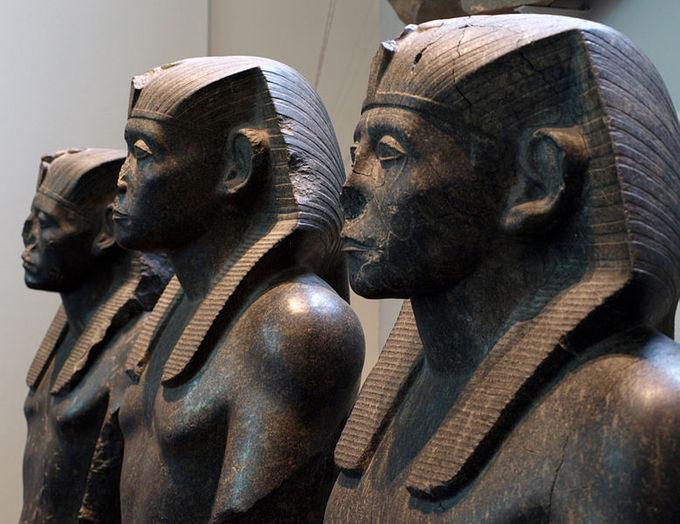
Aside from his accomplishments in architecture and war, Senusret III is known for his strikingly somber sculptures in which he appears careworn and grave. Deviating from the standard way of representing kings, Senusret III and his successor Amenemhat III had themselves portrayed as mature, aging men. This is often interpreted as a portrayal of the burden of power and kingship. The change in representation as ideological, and not something to be interpreted as the portrayal of an aging king, is shown by the fact that in one single relief, Senusret III was represented as a vigorous young man, following the centuries old tradition, and as a mature aging king.

Block Statues and Women Patrons
Another important innovation in sculpture that occurred during the Middle Kingdom was the block statue, which would continue to be popular through to the Ptolemaic age almost 2,000 years later. Block statues consist of a man squatting with his knees drawn up to his chest and his arms folded on top of his knees. Often, these men are wearing a wide cloak that reduces the body of the figure to a simple block-like shape. In some cases the cloak covers the feet completely, and in others the feet are left uncovered. The head of the sculpture contains the most detail.
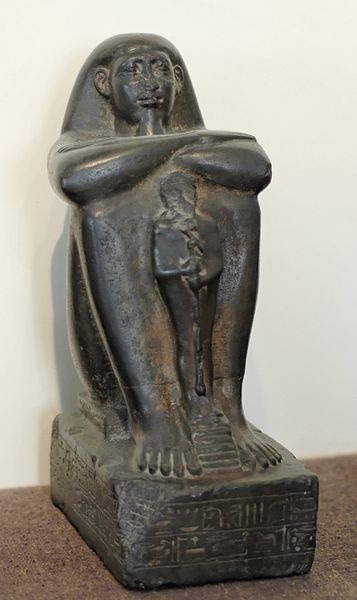
The sculpture pictured below—the fact that a private woman could have a sculpture made for herself—speaks volumes for the equality of gender in ancient Egypt. The heavy tripartite wig frames the broad face and passes behind the ears, thus giving the impression of forcing them forward. They are large in keeping with the ancient Egyptian ideal of beauty; the same ideal required small breasts, and in this respect, the sculpture is no exception. Whereas the natural curve of the eyebrows dips towards the root of the nose, the artificial eyebrows in low relief are absolutely straight above the inner corners of the eyes, a feature which places the bust early in the early Twelfth Dynasty. Around 1900 BCE, these artificial eyebrows, too, began to follow the natural curve and dipped toward the nose.
Tombs of the Middle Kingdom
Grand and royal tombs continued to be built for the deceased during the prosperous Middle Kingdom.
Learning Objectives
Compare and contrast the tombs and burial goods of the Middle Kingdom with those of the Old Kingdom.
Key Takeaways
Key Points
- As the pharaohs of the Middle Kingdom restored the country’s prosperity and stability, they stimulated a resurgence of art, literature, and monumental building projects, including tombs and burial goods .
- While burial goods continued to be common, objects of daily use were not typically included as they were in the Old Kingdom.
- Toward the end of the Middle Kingdom, new objects were introduced, such as shabtis and scarabs.
- Coffin Texts evolved from the previous Pyramid texts of the Old Kingdom, expanding and introducing spells that were more relatable to nobles and non-royal Egyptians.
Key Terms
- Pyramid Text:A collection of spells to protect the pharaoh from harm in the afterlife.
- Osiris:The god of the underworld and husband of the goddess Isis in the Egyptian pantheon. He is usually depicted with green skin and wrapped in a mummy’s linen.
- shabti:A figurine placed in tombs to act as servants for the deceased in the afterlife.
- sarcophagus:A stone coffin, often inscribed or decorated with sculpture.
- burial goods:Items included in tombs that were thought to be necessary in the afterlife, from everyday objects to jewelry and valuables.
Royal funerary practices in the Middle Kingdom remained much the same as in the Old Kingdom, with kings continuing to build pyramids for their burials. Unlike the Old Kingdom, however, Middle Kingdom royal pyramids were not quite as well constructed, and so few of them remain as pyramid structures today. Among the tombs built during this time are Amenemhat I’s funerary monument at El-Lisht; Sesostris I’s funerary monument; Amenemhat III’s pyramid at Hawara, which includes an elaborate labyrinth complex; and Sesostris II’s pyramid at Illahun. The construction of pyramids declined toward the end of the Twelfth Dynasty , as instability led to the decline of the Middle Kingdom.
Burial goods continued to be commonplace in tombs. Starting in the First Intermediate period, wooden models became very popular, often depicting everyday activities that the deceased expected to continue doing in the afterlife. The standard coffin was rectangular and brightly painted, often including an offering formula. Unlike the Old Kingdom, objects of daily use were not often included in the tombs; however, they reappeared toward the end of the Middle Kingdom.
Other new objects were introduced toward the end of the Middle Kingdom as well, including the first shabtis (also known as ushabtis) and the first scarabs. Shabtis were funerary figurines placed in tombs of the deceased to help them in the afterlife. Used from the Middle Kingdom until the end of the Ptolemaic Period nearly 2000 years later, most shabtis were of a small size, often covering the floor around a sarcophagus . Exceptional shabtis were of larger size, or produced as a one-of-a-kind master work. They were generally distinguished from other statuettes by being inscribed with the name of the deceased, his titles, and often with spells from the Coffin Texts. Shabtis were created to act as the deceased’s servants, performing the manual labor necessary for the plentiful existence of the afterlife.
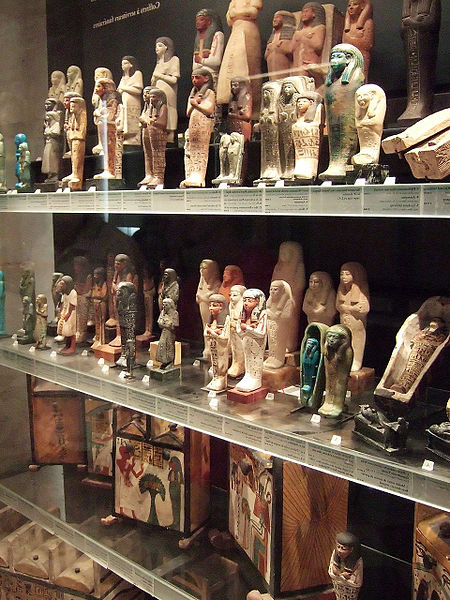
Scarabs were popular amulets believed to be protectors of written products. The scarab was also used as a holder or medium for personal name seals. A figurine of a scarab would be carved out of stone, and then on the smooth stomach of the scarab, the engraving of a seal was made.
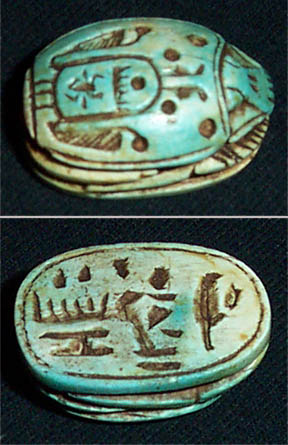
Another change in funerary practice during this time had to do with non-royal Egyptians. In contrast to elitist Old Kingdom attitudes towards the gods, the Middle Kingdom experienced an increase in expressions of personal piety and what could be called a democratization of the afterlife. In this worldview , all people possessed a soul and could be welcomed into the company of the gods after death.
In the Old Kingdom, the Pyramid Texts, which contained spells to help the dead reach the afterlife successfully, were only accessible to the elite. During the Middle Kingdom, Egyptians outside of the elite levels of society gained access to this funerary literature and began incorporating it into their own burials. Coffin Texts, as they are called by the scholars, expanded upon the Pyramid Texts, introducing new spells and incorporating slight changes to make them more relatable to the nobility. As seen in the image below, Coffin Texts could appear as paintings or inscriptions on the inside of the coffin. Due to the limited writing surfaces of some of these objects, the spells were often abbreviated, giving rise to long and short versions.
In contrast to the Pyramid Texts, which focus on the celestial realm, the Coffin Texts emphasize the subterranean elements of the afterlife ruled by Osiris in a place called the Duat. People of all classes had access to this afterlife, in which they would be judged by Osiris and his council according to their deeds in life. This realm is described as containing threatening beings, traps, and snares for which the deceased must be prepared. Spells in the Coffin Texts were intended to help the deceased contend with these impediments.
Stelae of the Middle Kingdom
The stelae of Ancient Egypt served many purposes, from funerary, to marking territory, to publishing decrees.
Learning Objectives
Describe the purposes of stelae in ancient Egyptian art
Key Takeaways
Key Points
- The earliest Egyptian stelae date back to the mid- to late third millennium BCE.
- Stelae are stone slabs that are inscribed, carved, or painted with imagery or text. While most were taller than they were wide, slab stelae took a horizontal dimension .
- Funerary stelae were generally built in honor of the deceased and decorated with their names and titles.
- Stelae also were used to publish laws and decrees, record a ruler’s exploits and honors, mark sacred territories or mortgaged properties, or to commemorate military victories.
- Obelisks , special forms of boundary stelae, were erected in pairs to mark the entrances of temples.
Key Terms
- obelisk:A tall, four-sided, narrow tapering monument which ends in a pyramid-like shape at the top.
- lintel:A structural horizontal block that spans the space or opening between two vertical supports.
- funerary:Of or relating to the interment or commemoration of the dead.
- stelae:Stone or wooden slabs, generally taller than they are wide, often erected for funerals commemorative purposes and decorated with images or text.
Egyptians were well known for their stelae, the earliest of which date back to the mid- to late third millennium BCE. Stelae are stone slabs that served many purposes, from funerary, to marking territory, to publishing decrees. Images and text were intimately interwoven and inscribed, carved in relief , or painted on the stelae. While most stelae were taller than they were wide, the slab stelae took a horizontal dimension and was used by a small list of ancient Egyptian dignitaries or their wives. The huge number of stelae surviving from ancient Egypt constitute one of the largest and most significant sources of information on those civilizations .
Funerary stelae were generally built in honor of the deceased and decorated with their names and titles. While some funerary stelae were in the form of slab stelae, this funerary stelae of a bowman named Semin (c. 2120-2051 BCE) appears to have been a traditional vertical stelae.
Slab stelae, when used for funerary purposes, were commonly commissioned by dignitaries and their wives. They also served as doorway lintels as early as the third millennium BCE, most famously decorating the home of Old Kingdom architect Hemon.
Stelae also were used to publish laws and decrees, to record a ruler’s exploits and honors, mark sacred territories or mortgaged properties, or to commemorate military victories. Much of what we know of the kingdoms and administrations of Egyptian kings are from the public and private stelae that recorded bureaucratic titles and other administrative information. One example of such stelae is the Annals of Amenemhat II, an important historical document for the reign of Amenemhat II (r. 1929–1895 BCE) and also for the history of Ancient Egypt and understanding kingship in general.
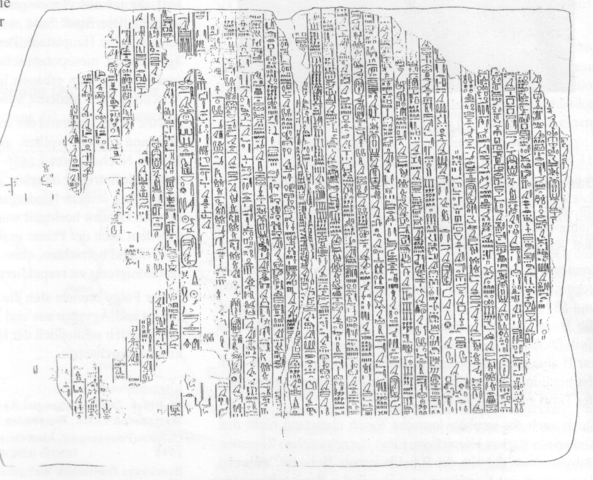
Many stelae were used as territorial markers to delineate land ownership. The most famous of these would be used at Amarna during the New Kingdom under Akhenaten. For much of Egyptian history, including the Middle Kingdom , obelisks erected in pairs were used to mark the entrances of temples. The earliest temple obelisk still in its original position is the red granite Obelisk of Senusret I (Twelfth Dynasty) at Al-Matariyyah in modern Heliopolis. The obelisk was the symbol and perceived place of existence of the sun god Ra.
Architecture of the Middle Kingdom
When Egypt had military and political security and vast agricultural and mineral wealth, its architecture flourished.
Learning Objectives
Describe the major building projects initiated during Egypt’s Middle Kingdom
Key Takeaways
Key Points
- The reign of Amenemhat III is known for its exploitation of resources and construction of the so-called “Black Pyramid .”
- Ancient Egyptian architects used sun-dried bricks, fine sandstone, limestone , and granite for their building purposes, though typically reserved stone for temples and tombs.
- Hieroglyphic and pictorial carvings in brilliant colors were abundantly used to decorate Egyptian structures.
- Senusret III is known for his construction of massive forts to defend the region after his many military campaigns.
- The Karnak Temple Complex is an example of fine architecture that was begun during the Middle Kingdom and continued through the Ptolemaic period.
Key Terms
- hieroglyph:An element of an Egyptian writing system.
As the pharaohs of the Middle Kingdom restored the country’s prosperity and stability, there was a resurgence of building projects. When Egypt had secured military and political security and vast agricultural and mineral wealth, its architecture flourished. Grand tombs in the form of pyramids continued to be built throughout the Middle Kingdom, along with villages, cities, and forts. The reign of Amenemhat III is especially known for its exploitation of resources, in which mining camps—previously only used by intermittent expeditions—were operated on a semi-permanent basis. A vast labor force of Canaanite settlers from the Near East aided in mining and building campaigns.
Ancient Egyptian architects used sun-dried bricks, fine sandstone, limestone, and granite for their building purposes. As in the Old Kingdom, stone was most often reserved for tombs and temples, while bricks were used for palaces, fortresses, everyday houses, and town walls. Mud was collected from the nearby Nile River, placed in molds, and left to dry and harden in the hot sun until they formed bricks for construction. Architects carefully planned all their work, fitting their stones and bricks precisely together. Hieroglyphic and pictorial carvings in brilliant colors were abundantly used to decorate Egyptian structures, and motifs such as the scarab, sacred beetle, solar disk, and vulture were common.
The “Black Pyramid” of Amenemhat III
The Black Pyramid, the first to house both the pharaoh and his queens, was built for Amenemhat III (r.
1860–1814 BCE). It is one of the five remaining pyramids of the original eleven pyramids at Dahshur in Egypt. Originally named Amenemhet is Mighty, the pyramid earned the name “Black Pyramid” for its dark, decaying appearance as a rubble mound. Typical for Middle Kingdom pyramids,
the Black Pyramid, although encased in limestone, is made of mud brick
and clay instead of stone. The ground-level structures consist of the
entrance opening into the courtyard and mortuary temple, surrounded by
walls. There are two sets of walls; between them, there are ten shaft
tombs, which are a type of burial structure formed from graves built
into natural rock. The capstone of the pyramid was covered with inscriptions and religious symbols.
Workers’ Villages and Forts
Workers’ villages were often built nearby to pyramid construction sites. Kahun (also known as El-Lahun), for example, is a village that was associated with the pyramid of Senusret II. The town was laid out in a regular plan, with mud-brick town walls on three sides. No evidence was found of a fourth wall, which may have collapsed and been washed away during the annual inundation. The town was rectangular in shape and was divided internally by a mud brick wall as large and strong as the exterior walls. This wall divided about one third of the area of the town, and in this smaller area the houses consisted of rows of back-to-back, side-by-side single room houses. The larger area, which was higher up the slope and thus benefited from whatever breeze was blowing, contained a much smaller number of large, multi-room villas, indicating perhaps a class separation between workers and overseers. A major feature of the town was the so-called “acropolis” building; its column bases suggest its importance.
Senusret III was a warrior-king who helped the Middle Kingdom reach its height of prosperity. In his sixth year, he re-dredged an Old Kingdom canal around the first cataract to facilitate travel to upper Nubia, using this to launch a series of brutal campaigns. After his victories, Senusret III built a series of massive forts throughout the country to establish the formal boundary between Egyptian conquests and unconquered Nubia. Buhen was the northernmost of a line of forts within signaling distance of one another. The fortress itself extended more than 150 meters along the west bank of the Nile, covering 13,000 square meters, and had within its wall a small town laid out in a grid system. At its peak, it probably had a population of around 3500 people. The fortress also included the administration for the whole fortified region. Its fortifications included a moat three meters deep, drawbridges, bastions, buttresses , ramparts, battlements, loopholes, and a catapult. The walls of the fort were about five meters thick and ten meters high .
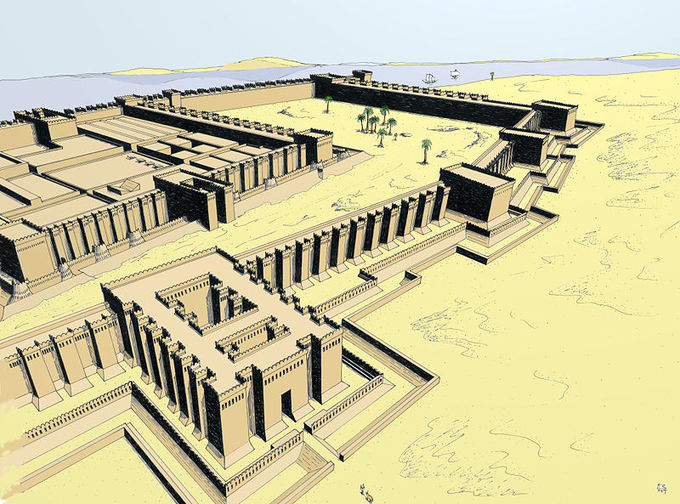
The Karnak Temple Complex
The Karnak Temple Complex is an example of fine architecture that was begun during the Middle Kingdom and continued through the Ptolemaic period. Built by Senusret I, it was comprised of a vast mix of temples, chapels, pylons , and other buildings. The White Chapel, also referred to as the Jubilee Chapel, is one of the finest examples of architecture during this time. Its columns were intricately decorated with reliefs of a very high quality. Later in the New Kingdom, the Chapel was demolished; however, the dismantled pieces were discovered in the 1920s and carefully assembled into the building that is seen today.
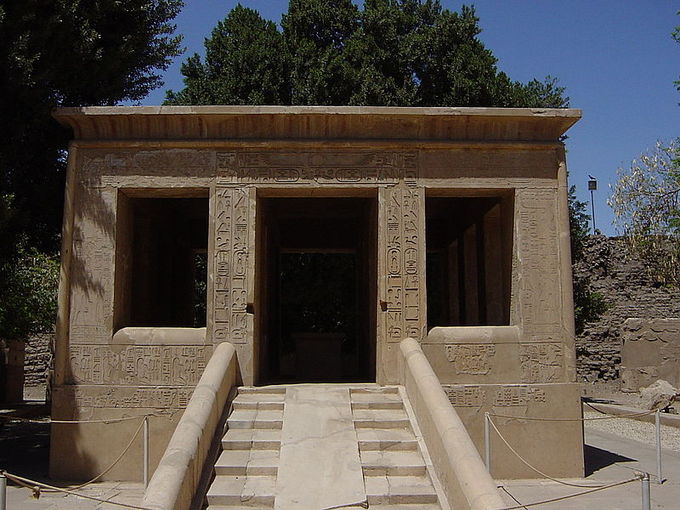
- Curation and Revision. Provided by: Boundless.com. License: CC BY-SA: Attribution-ShareAlike
- RedGraniteHeadOfSesostrisIII-BritishMuseum-August19-08. Provided by: Wikipedia. Located at: en.Wikipedia.org/wiki/File:RedGraniteHeadOfSesostrisIII-BritishMuseum-August19-08.jpg. License: Public Domain: No Known Copyright
- 509px-Louvre-antiquites-egyptiennes-p1020391.jpg. Provided by: Wikimedia Commons. Located at: commons.wikimedia.org/w/index.php?curid=394177. License: Public Domain: No Known Copyright
- Block statue Pa-Akh-Ra CdM. Provided by: Wikipedia. Located at: en.Wikipedia.org/wiki/File:Block_statue_Pa-Akh-Ra_CdM.jpg. License: Public Domain: No Known Copyright
- ThreeStatuesOfSesotrisIII-RightProfiles-BritishMuseum-August19-08. Provided by: Wikipedia. Located at: en.Wikipedia.org/wiki/File:ThreeStatuesOfSesotrisIII-RightProfiles-BritishMuseum-August19-08.jpg. License: Public Domain: No Known Copyright
- 315px-Head_and_Torso_of_a_Noblewoman,_ca._1844-1837_B.C.E._59.1.jpg. Provided by: Wikimedia Commons. Located at: commons.wikimedia.org/w/index.php?curid=33311525. License: CC BY-SA: Attribution-ShareAlike
- Middle Kingdom of Egypt. Provided by: Wikipedia. Located at: en.Wikipedia.org/wiki/Middle_Kingdom_of_Egypt. License: CC BY-SA: Attribution-ShareAlike
- Middle Kingdom of Egypt. Provided by: Wikipedia. Located at: en.Wikipedia.org/wiki/Middle_Kingdom_of_Egypt. License: CC BY-SA: Attribution-ShareAlike
- Ancient Egypt. Provided by: Wikipedia. Located at: en.Wikipedia.org/wiki/Ancient_Egypt%23Old_Kingdom. License: CC BY-SA: Attribution-ShareAlike
- Senusret III. Provided by: Wikipedia. Located at: en.Wikipedia.org/wiki/Senusret_III. License: CC BY-SA: Attribution-ShareAlike
- deified. Provided by: Wiktionary. Located at: en.wiktionary.org/wiki/deified. License: CC BY-SA: Attribution-ShareAlike
- Mentuhotep II. Provided by: Wikipedia. Located at: en.Wikipedia.org/wiki/Mentuhotep_II. License: CC BY-SA: Attribution-ShareAlike
- 12th Dynasty (1991 - 1783). Provided by: Saylor. Located at: http://www.saylor.org/site/wp-content/uploads/2011/09/12th-Dynasty-El-Lisht-Hawara-Illahun_1.pdf. License: CC BY: Attribution
- 360px-Coffin_of_Gua.jpg. Provided by: Wikimedia Commons. Located at: commons.wikimedia.org/w/index.php?curid=3804227%20. License: CC BY-SA: Attribution-ShareAlike
- Egyptian funerary figurines louvre 180flip. Provided by: Wikipedia. Located at: en.Wikipedia.org/wiki/File:Egyptian_funerary_figurines_louvre_180flip.jpg. License: Public Domain: No Known Copyright
- Scarab550bc. Provided by: Wikipedia. Located at: en.Wikipedia.org/wiki/File:Scarab550bc.jpg. License: Public Domain: No Known Copyright
- Scarab artifact. Provided by: Wikipedia. Located at: en.Wikipedia.org/wiki/Scarab_artifact. License: CC BY-SA: Attribution-ShareAlike
- Middle Kingdom of Egypt. Provided by: Wikipedia. Located at: en.Wikipedia.org/wiki/Middle_Kingdom_of_Egypt. License: CC BY-SA: Attribution-ShareAlike
- Ancient Egyptian tomb. Provided by: Wikipedia. Located at: en.Wikipedia.org/wiki/Ancient_Egyptian_tomb. License: CC BY-SA: Attribution-ShareAlike
- Shabti. Provided by: Wikipedia. Located at: en.Wikipedia.org/wiki/Shabti. License: CC BY-SA: Attribution-ShareAlike
- Mummification. Provided by: Wikipedia. Located at: en.Wikipedia.org/wiki/Mummification%23The_Egyptian_mummification_process. License: CC BY-SA: Attribution-ShareAlike
- Ancient Egypt. Provided by: Wikipedia. Located at: en.Wikipedia.org/wiki/Ancient_Egypt%23Old_Kingdom. License: CC BY-SA: Attribution-ShareAlike
- sarcophagus. Provided by: Wiktionary. Located at: en.wiktionary.org/wiki/sarcophagus. License: CC BY-SA: Attribution-ShareAlike
- burial goods. Provided by: Wikipedia. Located at: en.Wikipedia.org/wiki/burial%20goods. License: CC BY-SA: Attribution-ShareAlike
- Pyramid Text. Provided by: Wikipedia. Located at: en.Wikipedia.org/wiki/Pyramid%20Text. License: CC BY-SA: Attribution-ShareAlike
- Coffin Texts. Provided by: Wikipedia. Located at: en.Wikipedia.org/wiki/Coffin_Texts. License: CC BY-SA: Attribution-ShareAlike
- 593px-Annalenstein.png. Provided by: Wikimedia Commons. Located at: commons.wikimedia.org/w/index.php?curid=25589325. License: Public Domain: No Known Copyright
- 360px-Funerary_stele_of_bowman_Semin.jpg. Provided by: Wikimedia Commons. Located at: commons.wikimedia.org/w/index.php?curid=2757021. License: CC BY-SA: Attribution-ShareAlike
- 320px-Heliopolis200501.jpeg. Provided by: Wikimedia Commons. Located at: commons.wikimedia.org/w/index.php?curid=15285922. License: Public Domain: No Known Copyright
- Slab stela. Provided by: Wikipedia. Located at: en.Wikipedia.org/wiki/Slab_stela. License: CC BY-SA: Attribution-ShareAlike
- Obelisk. Provided by: Wikipedia. Located at: en.Wikipedia.org/wiki/Obelisk. License: CC BY-SA: Attribution-ShareAlike
- Stele. Provided by: Wikipedia. Located at: en.Wikipedia.org/wiki/Stele. License: CC BY-SA: Attribution-ShareAlike
- Middle Kingdom of Egypt. Provided by: Wikipedia. Located at: en.Wikipedia.org/wiki/Middle_Kingdom_of_Egypt. License: CC BY-SA: Attribution-ShareAlike
- Ancient Egypt. Provided by: Wikipedia. Located at: en.Wikipedia.org/wiki/Ancient_Egypt. License: CC BY-SA: Attribution-ShareAlike
- funerary. Provided by: Wiktionary. Located at: en.wiktionary.org/wiki/funerary. License: CC BY-SA: Attribution-ShareAlike
- Boundary Stelae of Akhenaten. Provided by: Wikipedia. Located at: en.Wikipedia.org/wiki/Boundary_Stelae_of_Akhenaten. License: CC BY-SA: Attribution-ShareAlike
- Annals of Amenemhat II. Provided by: Wikipedia. Located at: en.Wikipedia.org/wiki/Annals_of_Amenemhat_II. License: CC BY-SA: Attribution-ShareAlike
- Lintel. Provided by: Wikipedia. Located at: en.Wikipedia.org/wiki/Lintel. License: CC BY-SA: Attribution-ShareAlike
- Senusret I. Provided by: Wikipedia. Located at: en.Wikipedia.org/wiki/Senusret_I. License: CC BY-SA: Attribution-ShareAlike
- 589px-Black_Pyramid_of_Amenemhat_III..JPG. Provided by: Wikimedia Commons. Located at: commons.wikimedia.org/w/index.php?curid=12634500. License: CC BY-SA: Attribution-ShareAlike
- White Chapel. Provided by: Wikipedia. Located at: en.Wikipedia.org/wiki/File:White_Chapel.jpg. License: Public Domain: No Known Copyright
- Buhen3. Provided by: Wikipedia. Located at: en.Wikipedia.org/wiki/File:Buhen3.jpg. License: Public Domain: No Known Copyright
- Buhen. Provided by: Wikipedia. Located at: en.Wikipedia.org/wiki/Buhen. License: CC BY-SA: Attribution-ShareAlike
- El-Lahun. Provided by: Wikipedia. Located at: en.Wikipedia.org/wiki/El-Lahun. License: CC BY-SA: Attribution-ShareAlike
- Ancient Egypt. Provided by: Wikipedia. Located at: en.Wikipedia.org/wiki/Ancient_Egypt%23Old_Kingdom. License: CC BY-SA: Attribution-ShareAlike
- Karnak. Provided by: Wikipedia. Located at: en.Wikipedia.org/wiki/Karnak. License: CC BY-SA: Attribution-ShareAlike
- Ancient Egyptian architecture. Provided by: Wikipedia. Located at: en.Wikipedia.org/wiki/Ancient_Egyptian_architecture. License: CC BY-SA: Attribution-ShareAlike
- El-Lisht. Provided by: Wikipedia. Located at: en.Wikipedia.org/wiki/El-Lisht. License: CC BY-SA: Attribution-ShareAlike
- White Chapel. Provided by: Wikipedia. Located at: en.Wikipedia.org/wiki/White_Chapel. License: CC BY-SA: Attribution-ShareAlike
- Middle Kingdom of Egypt. Provided by: Wikipedia. Located at: en.Wikipedia.org/wiki/Middle_Kingdom_of_Egypt. License: CC BY-SA: Attribution-ShareAlike
- hieroglyph. Provided by: Wikipedia. Located at: en.Wikipedia.org/wiki/hieroglyph. License: CC BY-SA: Attribution-ShareAlike
- Pyramid of Amenemhat III (Dahshur). Provided by: Wikipedia. Located at: en.Wikipedia.org/wiki/Pyramid_of_Amenemhat_III_(Dahshur). License: CC BY-SA: Attribution-ShareAlike

